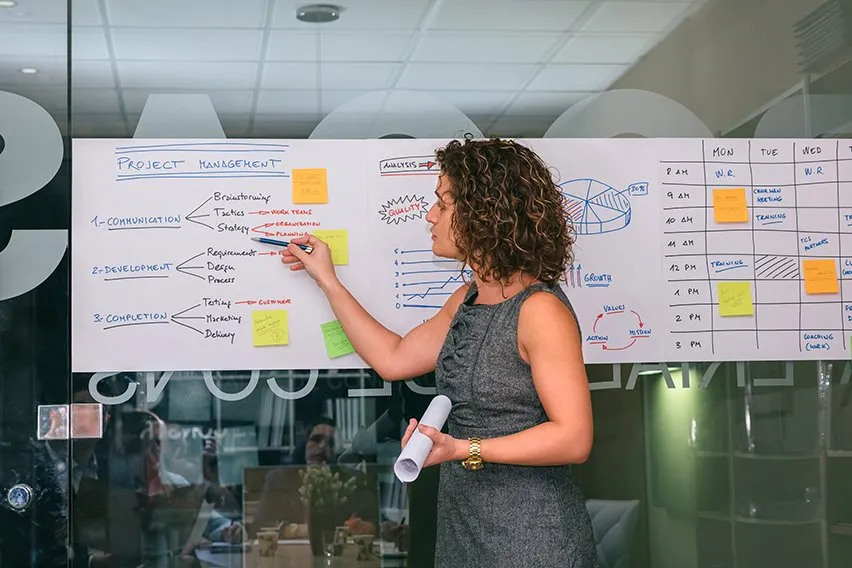Project Initiation: Guide to Kickstart Your Project the Right Way

Starting your project on the right foot is crucial. So, before you rush into planning your marketing strategy, pause and take a step back. Project initiation requires many steps before the real work begins.
But what is project initiation? And how can you do it well? Keep reading to learn what it is, why it’s important, and how to overcome any challenges.
Table of Contents
What Is the Importance of the Project Initiation Phase?
Project Initiation: Challenges & How to Overcome Them
What Is Project Initiation?
Project initiation is the first stage of developing a new project. It should come before any official project planning takes place. It lays the groundwork for all the critical planning steps needed to launch a successful project.
The project initiation phase is when you should establish a project’s guiding vision. By the end of this phase, you should have a clear idea of why the project exists and what it will achieve.
This is not the moment for highly-detailed profitability models or task lists. Instead, you should use the initiation phase to lay out the big picture and develop a clear definition of your objectives. You’ll need a compelling story to capture the interest of key decision-makers in your company and secure their support. Only after you’ve received the green light can you start building the project plan.
Project initiation is the first of 5 phases of project management. That’s according to the model created by the Project Management Institute (PMI). You can find further details in their Guide to the Project Management Body of Knowledge (PMBOK Guide). The phases are:
- Project initiation: Define expectations and secure buy-in
- Project planning: Describe deliverables and lay out the project roadmap
- Project execution: Launch the project according to the plan
- Project performance: Track effectiveness with key performance indicators (KPIs)
- Project closure: Wrap-up with stakeholders

What Is the Importance of the Project Initiation Phase?
Why is the project initiation phase so important? For one, it forces you to take a step back and consider the why of the project instead of focusing on the how. Some teams get too caught up in clever marketing strategies and exciting features. In doing so, they forget to consider if a project is delivering value that aligns with key company objectives.
The project initiation phase helps you get the necessary approval from influential stakeholders. Stakeholders want to see a clear value proposition and a plan that anticipates potential risks and roadblocks.
To gain approval, the project team should adopt a structured approach and prove project feasibility with quality data to back it up. This empowers decision-makers to make confident decisions and pass sound judgement.
This phase doesn’t guarantee success. But it does provide justification for moving forward. A successful project initiation phase should:
- Get everyone on the same page
- Secure essential resources
- Gain visibility
- Predict risks
- Produce guiding documentation
- Inspire confidence
- Prove value
Process of Project Initiation
Project initiation can vary from person to person. But no matter the group, there are generally 4 major steps in the process. These are:
Step 1: Draft a Business Case or Project Charter
The first step is to answer this question: “Why should we do this?” You’ll need to craft a business case and project charter. Both documents should justify your answer and explain the project’s value to the organisation. But there are a few key differences.
A business case is often created first. You use this document to sell the project idea to senior leadership. It should provide a general overview of the project’s scope and the results you will achieve.
While it doesn’t go in-depth in planning individual actions, a business case shouldn’t be vague. Instead, it should be logical, clear, and backed up by research data whenever possible. The main goal is to make the project look necessary and feasible.
Business cases should include:
- An executive briefing (what the project is about and why it provides value)
- Projected costs (financial analysis, estimated ROI, budget)
- Expected benefits (include both risks and rewards)
- Overview of next steps (action plan)
A project charter examines the project in greater detail. It takes the general vision of the business case and narrows it down to 3 main components:
- What: project scope
- Who: key stakeholders
- When: project timeline
Your project charter should define the goals, objectives, and deliverables. It should also go in-depth on the budget, timeline, risks, and stakeholder roles and responsibilities.
Step 2: Enlist Key Stakeholders
Stakeholders are the people who are most directly affected by the project. They may include clients, team members, or executives within the organisation.
Not sure who your stakeholders are? These are the people who can:
- Approve your project
- Direct resources toward the project
- Influence the outcome of your project
It’s good practice to gain input from key stakeholders early in the project initiation phase. Ask them for their opinions and see if they can help secure support or resources. This will help you stay aligned with your stakeholder interests throughout the planning process. Otherwise, you risk pitching a project no one needs or wants.
Step 3: Study Feasibility
A feasibility study provides the rationale needed to move forward to the next stage of planning. It should prove that your project can succeed with the requested budget and resources. You should consider all the risks that may cause project failure.
For example, are your project costs too high? Do you have enough personnel to see it through? Is this the right time to proceed with the project? What’s the return on investment for the organisation as a whole?
You must base the feasibility study on robust data. Look at past projects for reference and see what worked or didn’t work. Don’t rush this stage—it’s critical to obtaining project approval.
Step 4: Gather Team and Resources
Now that you’ve proved your project’s feasibility, it’s time to assemble the team. People will make or break a project in the long run, so choose wisely and consider the following factors:
- Team structure. How is your team organised? Will they all report to one project manager, or will you adopt a more horizontal hierarchy? How big is your team? Are they divided according to their roles or by geographical region?
- Team skills. What skills will ensure project success? What ratio of technical to non-technical roles will best serve the project? Who in your company has these skills? Do you need to hire outside of the team?
- Project office. Where will you work? Will you be working remotely or face-to-face? Do you have the proper communication infrastructure to manage your working environment?
- Project tools. What tools will your team need? How will you onboard everyone to ensure they’re proficient with the chosen tools?
Once you’ve got the green light to move ahead with the project, you can move to the planning phase. This is where you’ll dive into the details of the deliverables and come up with an action plan for achieving them.
Project Initiation: Challenges & How to Overcome Them
The project initiation phase requires a lot of work, but the results are worth it. Some of the main challenges you may face when initiating a project include the following:
Unclear Project Strategy
Although it may seem obvious, your project should align with the organisation’s business strategy. If you have misaligned strategic goals, your project won’t get approved. You may end up wasting your efforts.
To increase your chance of success, conduct detailed analyses before initiating a project. Use SWOT, PERT, or other environmental analyses to conduct your research. Use the organisation’s business strategy as a starting point. And determine how your project can fill gaps and encourage progress.
Lack of Resources
When starting a new project, you may not have all the pieces you need right away. Whether it’s the right personnel or administrative resources, you’ll likely have to justify extra costs.
Have a clear description of all the roles in your project. For instance, you might realise you have the necessary staff already in your company. It will save money and time if you can shift around personnel already in your organisation.
Shortage of Support
All project initiation plans need approval from upper management. Engage with stakeholders early in the initiation phase. Get a sense of their thoughts on the project and its feasibility.
Identify some of your project stakeholders and present them with your preliminary assessment. Use their feedback to revise your documentation before submitting it for final approval. If you can gather support before the review process begins, you can gain momentum toward project approval.
Project Initiation Tips
Here are some quick tips that summarise the best practices laid out in this article:
- Be specific about success and cite quality data to back up your claims.
- Get a second opinion from one or more stakeholders. It’s smart to read the room before presenting your case.
- Anticipate project risks. And make sure the benefits outweigh these risks.
- Prioritise influential stakeholders who your project will most impact. Align your project goals with their expectations.
- Conduct research on the market and your project’s financial feasibility. Make a map of your funding strategy.
- Describe logistical strategies for personnel, equipment, and facilities. Again, it would help if you had a good idea of how to achieve the project in a practical manner.
- Reference past projects that show similarities to your own. This will provide context and help you know what to include in your proposal.
- Pick the right team. We cannot understate this part enough. Ask for input where you can. And work together to find the right balance between ambition and feasibility.
Key Takeaways
Project initiation is the first of 5 project planning phases created by the Project Management Institute (PMI). It’s followed by the planning, execution, performance, and closure stages. The main goal of project initiation is to define a project’s purpose and secure buy-in from stakeholders.
Remember, the project initiation phase is for setting expectations, not task lists. Focus on the big picture, and don’t get too caught up in the details.
Sure, there is always a chance that your project won’t get the green light. Still, you should always follow the best project initiation practices. This way, you can create a vision that captures the interest of key decision-makers. And you can lay the groundwork for success.
FAQs on Project Initiation
What Is a Project Initiation Example?
Let’s look at an example of project initiation. Suppose a health foods company sees an increased demand for plant-based meat in a new area. In that case, they might respond to this consumer demand by initiating a project to launch new plant-based products.
What Is the Difference Between the Initiation and Planning Phases?
The initiation phase lays the foundation for the planning phase. It establishes a clear project scope and identifies key stakeholders. It also determines feasibility, tools, and the appropriate team. Meanwhile, the planning phase sets deliverables and milestones, and it lays out the project roadmap.
What Is a Project Initiation Meeting?
A project initiation meeting is an internal meeting that introduces a team to a new project. It’s a crucial step in the project initiation process because it gets everyone on the same page. The team leader will cover the project background, scope, roles, and action plan.
What Are the Types of Project Initiation Documentation?
A project initiation document (PID) defines a project before it begins. It can be a single document or made up of several documents. It will include a project definition, goals, scope, and business case.
It will also include key stakeholders, risks and risk management, and team structure. Finally, it will include role descriptions, the project plan, and project controls.
Who Is Involved in Project Initiation?
A project life cycle might have involvement from many different people. It depends on the project’s scope. Some of the most common roles may include the project leader, project manager, and project team. Roles may also include a project client, resource manager, consultants, or stakeholders.
What Are the Major Outputs of the Project Initiation Phase?
Your project team should produce a few outputs after the project initiation process. These include the project charter, plus review and approval of that charter. Also included are a project initiation meeting and stakeholder register.
RELATED ARTICLES


 Matrix Organisational Structure: Definition, Pros & Cons
Matrix Organisational Structure: Definition, Pros & Cons Risk Register: What It Is and How to Create One
Risk Register: What It Is and How to Create One What Are Profitability Ratios? Definition, Types & Importance
What Are Profitability Ratios? Definition, Types & Importance What Is Compensation Management? Definition & Importance
What Is Compensation Management? Definition & Importance 8 Reasons Why Is Collaboration Important in the Workplace?
8 Reasons Why Is Collaboration Important in the Workplace? Product Manager Vs Project Manager: What’s the Difference
Product Manager Vs Project Manager: What’s the Difference